Abstract:
The Pacific Yew (Taxus brevifolia) and the English Yew
(Taxus baccata) are used as active plant ingredients for the
anti-cancer drug Taxol, which is produced by the Bristol-Myers
Squibb Company. Paclitaxel, another name for Taxol, works
against cancer by interfering with mitosis, where it breaks
down the mitotic spindle during cell division, which prevents
the cell from dividing into daughter cells.
The production of Taxol caused problems, when after
harvesting the bark of the Pacific Yew, the trees died.
Because of this, the Bristol-Myers Squibb Company had to find
a new source to get the active ingredient, which they found in
the English Yew. Taxus baccata is not only more effective, but
also not harmful to the trees because only the needles and
twigs are used to produce Taxol.
The Pacific Yew is found in the Northwestern part of the
United States and Canada, the English Yew in parts of
Vermont.
Introduction:
When researching for 10 prescription drugs that contain
active plant ingredients, Taxol was one of the most
interesting medicines. During the history of this drug the
active plant ingredient changed from the bark of the Pacific
Yew (Taxus brevifolia) to the needles and twigs of the English
Yew (Taxus baccata). The reason behind this change was that
when the bark of the Pacific Yew was harvested, not only the
plant itself died, but also the lives of animals like the
spotted owl that lived in the same habitat were
threatened.
The Pacific Yew or Taxus brevifolia is a small evergreen
tree with indistinct growth form. It grows in moist soils in
British Columbia, Alaska, California, Idaho, Montana, Oregon,
and Washington. The Pacific Yew can reach up to 50 feet in
height and two feet in diameter. The needles are single,
linear, and spirally arranged, about one inch long, yellow-
green to dark green above and paler below. The male flowers
are small, round, and yellow and are borne on the underside of
the leaves, while female flowers are solitary. The fruits of
the Pacific yew are round, fleshy, and of an orange-red
color.
The English Yew or Taxus baccata is also a small evergreen
tree or large shrub with numerous limbed boles and a short
trunk. Its leaves are alternate, simple, two-ranked linear,
and approximately one inch long. They appear dark green and
shiny on top, yellow or pale green on the bottom. The fruit is
a naked ovoid seed about ¼ inch long, surrounded by a bright
red, fleshy aril. The English Yew matures in the late summer.
Taxus baccata is native to England, but has been introduced to
some parts in the Northeastern United States, mainly
Vermont.
Historically, Native American tribes used yew brews to
treat rheumatism, fever, and arthritis. The Japanese used yew
leaves to treat diabetes and to induce abortion.
Methods:
Information and pictures used in the report on Taxol®,
English yew (Taxus baccata), and Pacific yew (Taxus
brevifolia) was obtained from web sites off of the
Internet. To view the web pages used, see the reference
section of this report. Taxol is a registered trademark of
Bristol-Myers Squibb.
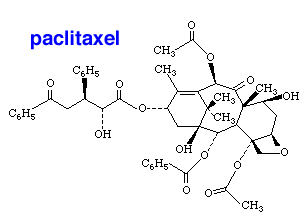
Figure 1.
Taxol molecular structure
Paclitaxel, which is sold as Taxol by
Bristol-Myers Squibb, binds to microtubules and inhibits their
depolymerization (molecular disassembly) into tubulin. This
means that paclitaxel blocks a cell's ability to break
down the mitotic spindlem during mitosis (cell division). With
the spindle still in place the cell can't divide into daughter
cells (this is in contrast to drugs like colchicine and the
Vinca alkaloids, which block mitosis by keeping the spindle
from being formed in the first place).
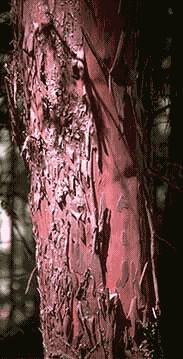
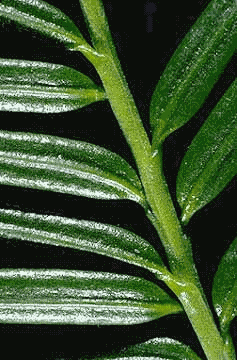
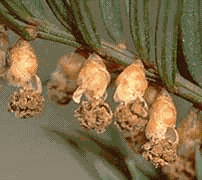
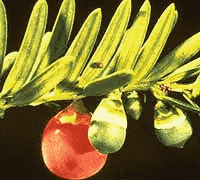
Figure 2.
Pacific yew (Taxus brevifolia)
Pacific yew (Taxus brevifolia)
characteristics:
Leaf: Needles single, linear, and spirally arranged
(although they appear 2-ranked), 1 inch long, yellow-green to
dark green above and paler below (but without bloom), apex
pointed but not sharp, each needle has a distinct petiole that
parallels the twig for a short distance.
Flower: Dioecious, male flowers are small, round, and
yellow and are borne on the undersides of the leaves; Female
flowers are solitary.
Fruit: A round, fleshy, orange-red aril about 1/4 inch
long containing one hard seed, exposed at the end.
Twig: Round, slender, and remaining green for many
years, relatively few lateral branches.
Bark: Always thin (about 1/4 inch), reddish-brown, and
scaly, inner bark is reddish-purple.
Form: Small evergreen understory tree with indistinct
growth form. Can reach 50 feet tall and 2 feet in diameter,
but usually much smaller. Trunks are usually fluted and
asymmetrical. Very slow growing but can reach a very old age.
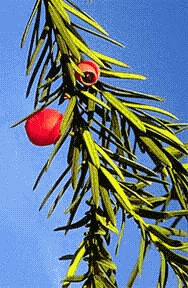
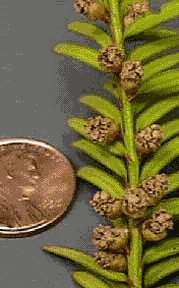
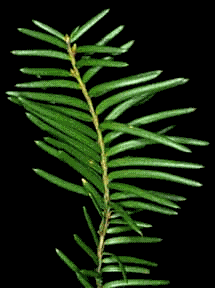
Figure 3. English yew (Taxus
baccata)
English yew (Taxus
baccata)characteristics:
Leaf: Evergreen, alternate, simple, 2-ranked, linear,
approximately 1 inch long, dark green and shiny above, yellow
or pale green below.
Flower: Male is a globose strobili; female is a small
stalked bud in leaf axils.
Fruit: A naked ovoid seed 1/4 inch long, surrounded by
a bright red, fleshy aril. Maturing late summer, persistent
through autumn.
Twig: Light green in color, turning brown after several
years.
Bark: Dark, usually red-purple, and scaly or somewhat
peeling.
Form: Small tree or large shrub with many limbed boles
and a short trunk.
Discussion:
The purpose of Taxol (paclitaxel) is to help fight
cancer, especially ovarian carcinomas and advanced breast
cancer. The medication interferes with mitosis by breaking
down the mitotic spindle, which prevents the cell from
dividing into daughter cells. Taxol is an intravenous drug
that is administered by a doctor over a 24-hour period in
21-day intervals. This drug not only has benefits, but also
severe side effects, including anaphylactic reactions, which
can be life threatening, if not treated shortly after the
injection. Other less serious side effects include the loss of
hair, pain in joints, painful urination, nausea, and vomiting
among many others.
Unfortunately, controversy surrounded the use of the
Pacific Yew in Taxol. Taxus brevifolia is the plant
that was originally used in Taxol. This tree is found in the
Pacific Northwest of the United States and Canada. The drug
was harvested from the bark of this rare species. However, by
removing the bark of the Pacific Yew, the tree was killed,
which led to another problem. By killing the tree,
environmental groups felt that it also threatened the home of
a federally protected and endangered species, the spotted
owl.
Bristol-Myers, the maker of the drug, felt compelled to
find an alternative source of paclitaxel for commercial
production. Researchers found that the needles and twigs of
another type of yew, the English Yew or Taxus Baccata, can be
used to produce a semisynthetic form of the drug, which
requires less raw material and also protects the yew tree.
Over the past few years Bristol-Myers has received the
approval to collect twigs and needles from the plant in both
public and private gardens. This is a big step forward because
by using cultivated trees improves the consistency and quality
of the raw material. In the end, environmental improvements in
the production of Taxol, gives patients more opportunities to
extend their lives.
Conclusion:
- Taxol is use to help fight ovarian carcinomas and
advanced breast cancer.
- Taxol is derived from twigs and needles of the English
Yew
References:
Description and Natural History of the English
and Pacific Yew.
English Yew Fact Sheet: English
Yew-Taxaceae-Taxus Baccata.
Pacific Yew Fact Sheet: Pacific
Yew-Taxaceae-Taxus Brevifolia.
Pharmacology of Paclitaxel and Docetaxel.
The Environmental Story.







